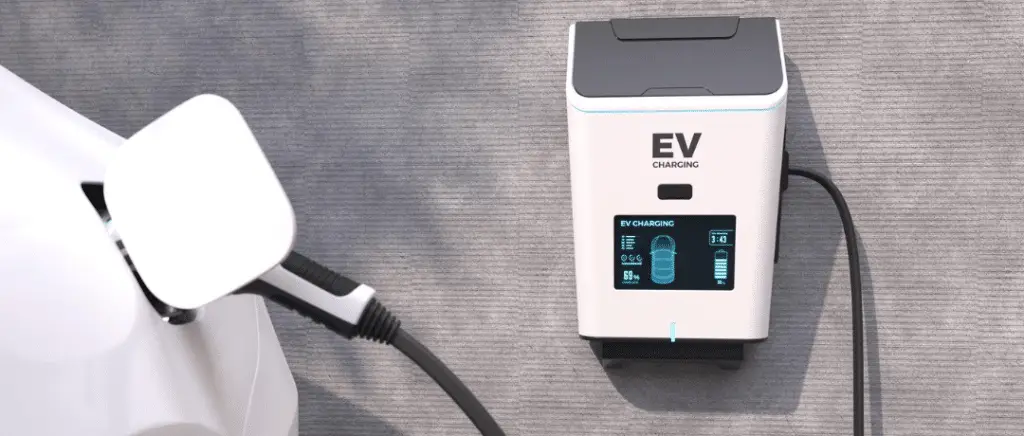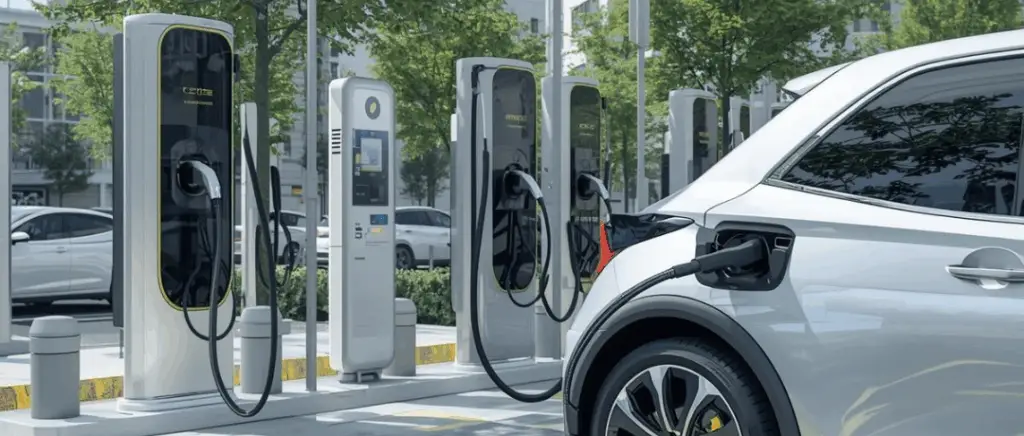Monday to Friday
9am - 12.30pm - 2pm - 7pm
The development of fast-charging stations
What technological advances have been made?
The history of fast-charging stations is linked to the rise of electric vehicles, a revolution that began more than a decade ago. In the beginning, recharging infrastructures were simple and ill-suited to the needs of drivers on long-distance journeys. The first charging points offered slow charging with a power of from 2 to 3 kWThis made electric cars less attractive.
Today, fast-charging stations have arrived on the scene. With a capacity of up to up to 350 kWThis technological innovation marked a decisive turning point. They enable battery an electric vehicle from 20% to 80% in less than 30 minutes as the Kia EV6 or theHyundai Ioniq 5. This progress has not only made electric vehicles more practical, but has also made long-distance travel feasible and comfortable.
The development of fast-charging stations has been stimulated by several factors:
- R&D investment has increased compatibility with different models of electric car,
- Collaboration between vehicle manufacturers, energy suppliers and the government has enabled the French network of charging points to be extended,
- Innovations in battery technology have made it possible to increase theautonomy electric vehicles, reducing concerns about range.
The focus today is therefore on the next generation of charging stations, which promise even shorter charging times and an enhanced user experience. Innovations such as ultra-fast recharging and wireless recharging are currently being developed.
Also read → Charging stations: what's the current state of deployment?
What role do innovations play in the autonomy of electric vehicles?
Technological innovations play a central role in improving the range of electric vehicles. This improvement in range has been made possible by a series of significant advances.
Advances in battery technology
One of the most decisive factors in the range of an electric vehicle is the capacity of its battery. Advances in battery chemistry, such as the development of more efficient lithium-ion batteries, have made it possible to store more energy in smaller spaces, increasing range without compromising performance or interior space. For example, solid electrolyte batteries, a recent innovation, promise even higher energy density, potentially offering up to 50% more range than current lithium-ion batteries.
Optimising energy management systems
Efficient energy management is essential to maximise the range of electric cars. Innovations in energy management systems, such as advanced battery management software, can precisely control the charging and discharging of batteries, reducing energy wastage and extending battery life. These systems can also adapt the behaviour of the electric vehicle.
The integration of intelligent technologies
Another crucial advance is the incorporation of intelligent technologies into electric vehicles. Using artificial intelligence and machine learning, electric cars can optimise their energy consumption in real time, adjusting their performance according to traffic, road surface or even the weather. These intelligent systems can also predict driver behaviour, adjusting energy recovery during braking to maximise battery recharging without driver intervention.
Also read → 10 innovations that promise to revolutionise electric car technology
Improving accessibility for drivers
Thanks to the progress made in deploying charging infrastructure, drivers can now plan their long-distance journeys with renewed confidence, knowing that they will have access to fast, reliable charging points along the way.
A larger network of charging points
From motorways to urban and rural areas, the installation of fast-charging stations has accelerated, offering drivers a multitude of options for recharging their vehicles on the move. This growing network provides wider coverage, reducing 'white' areas where charging points were previously non-existent.
Connected applications and services
Alongside the expansion of charging points, digital innovation is playing a key role in accessibility. Mobile applications such as Chargemap or Plugshare provide real-time information on the location and availability of recharging points, as well as estimated recharging times. These digital tools make it easier to plan journeys, enabling drivers to easily locate a fast charging point on their route and manage their journey time more efficiently.
Standardisation and compatibility
Standardisation of charging connectors and improved compatibility between different vehicle models and charging points also contribute to improved accessibility. Efforts to harmonise charging systems around the world aim to simplify the charging experience for all electric car drivers, removing technical barriers that might otherwise limit the use of fast-charging stations. This standardisation ensures that drivers can recharge at almost any station without worrying about compatibility, making long-distance journeys even more accessible.
Also read → The best applications for electric cars
What are the benefits of reducing downtime for recharging?
Perfectly aligned with the time of a break
The average time spent taking a break on a long car journey to eat, use the toilet or simply stretch the legs is the same as the time needed for a quick charge. This synchronisation gives electric car drivers the opportunity to optimise their stops, by combining recharging their vehicle with their breaks, without extending the journey time.
Plan your travels with greater peace of mind
Reducing the time spent stopping to recharge has a direct impact on the planning of long-distance journeys in electric cars. Drivers can now look forward to longer journeys with less apprehension, safe in the knowledge that recharging breaks do not significantly impede their progress. This is particularly beneficial for families and professionals on the move, for whom time is precious.
Also read → What are the benefits of a recharging point?
What are the challenges and solutions for infrastructure development?
Investments and strategic partnerships
Internationally
The International Energy Agency forecasts a significant increase in the number of electric vehicles, estimating their number at at least 145 million by 2030. This expansion represents a huge potential for reducing petrol consumption and CO2 emissions.
In France
La energy transition law for green growth is supporting this drive, with the aim of installing seven million electric charging points by 2030. This initiative illustrates the importance of regulatory frameworks and government incentives to encourage private investment and partnerships in electric charging.
In Europe
At the same time, Europe-wide financial incentives are encouraging the purchase of electric vehicles and the installation of charging stations. In France, buyers of electric cars can benefit from an ecological bonus of up to 7,000 eurosThe United Kingdom, on the other hand, offers the best of both worlds. Plug-In Grant to 2,500 pounds and the Electric Vehicle Homecharge SchemeGermany offers a range of services to help homeowners and employers install chargers. Germany offers UmweltBonus to stimulate the adoption of clean models.
Encouraging government and private initiatives
Legislative and regulatory measures are playing a key role in the development of charging infrastructure for electric vehicles (IRVE):
- the ADVENIR programmeIt provides financial support for the deployment of individual or shared recharging points in collective residential buildings.
- the tax credit with support up to 75% expenditure on the purchase and installation of a controllable charging point, up to a maximum of €500.
- the reduction in VAT rateby applying a reduced rate of 5.5% for the installation and maintenance of home charging points.
- the law on the orientation of mobility (LOM), which reinforces the requirement for car parks in new or renovated buildings to be pre-equipped to facilitate the future installation of recharging points.
- the climate law and resilience obliging car parks managed under a public service delegation contract, a public service contract or a public procurement contract to install equipment.
- the right to collective buildings allowing any occupant of a private parking space to equip it, at their own expense, with a recharging point.
- the provisions relating to IRVEs open to the public Decreeing that all service areas on the motorway network must be equipped with recharging stations for electric vehicles.
What does the future hold for long-distance electric travel?
Future innovations in recharging technology
Dual-chemistry batteries
These innovative batteries combine two different types of chemistry within the same system, for example lithium-ion and lead-acid, to offer greater energy density, durability and performance. Companies such as Tesla and BMW are using this technology, which promises to improve the range of electric vehicles.
V2G and bidirectional charging technologies
V2G (Vehicle-to-Grid) allows electric vehicles to send electricity back to the grid, helping to balance demand and supply. V2H (Vehicle-to-Home) and V2L (Vehicle-to-Load) extend these possibilities, allowing vehicles to supply electricity to homes or other loads. Models such as the Kia EV6 and the Hyundai Ioniq 5 are already equipped with this technology, and many other companies are interested.
Wireless recharging
Induction charging could enable electric vehicles to recharge without the need for a physical connection, simplifying the charging process. This technology could be integrated into dedicated spaces, car parks or even certain roads, allowing charging while driving. Companies such as Witricity are leading the way in this field, forecasting significant growth in the market for wireless charging systems.
Also read → Electric car charging points: what innovations are on the horizon?
Expanding the network of fast-charging stations
Expanding the network of fast-charging stations is essential to support the future of long-distance electric travel. This expansion is underway worldwide, with initiatives by both governments and the private sector to increase the number and efficiency of these charging infrastructures.
A study by the International Council on Clean Transportation highlights the importance of expanding charging infrastructure to keep pace with the expected increase in the number of electric vehicles. The report suggests that, to meet the growing demand, the number of public charging points would have to increase eightfold by 2030, from around 5,700 to 45,800 standard charging points and 700 to 6,300 fast-charging stations. This expansion will require close collaboration between the government and the private sector to achieve these objectives.
In Europe, the Ionitysupported by the automotive giants Volkswagen, BMW and Fordis a major player in the expansion of fast-charging infrastructures. It has set up 3,525 fast-charging stations across Europe offering refills ranging from up to 350 kW making long-distance travel easier.
Similar efforts are being made in the retail sector, with Lidl having already announced 900 charging points to be installed by 2021 in France, exploiting the development potential of a large number of recharging sites across Europe. This demonstrates the commitment of private companies to the development of a recharging infrastructure more accessible.
Conclusion
The rise of fast-charging stations is radically transforming long-distance travel, making electric vehicle journeys more convenient and accessible. Not only is this encouraging the adoption of electric mobility, it's also contributing to a more sustainable future. Our experts in electric cars on lease and installation of recharging stations are available to help you with your charging point project. Contact them to explore the options best suited to your needs.
If you would like to find out more about the tax credit for in-car charging points 2024For more information, see our article on this subject.
































